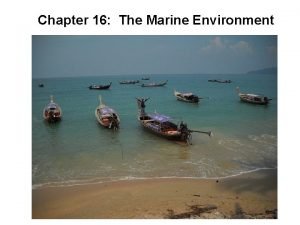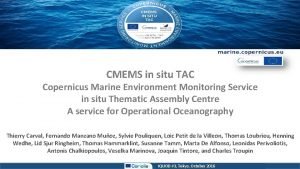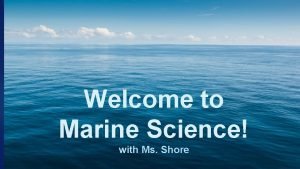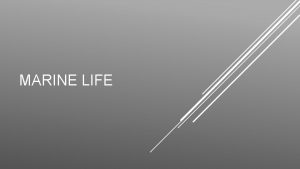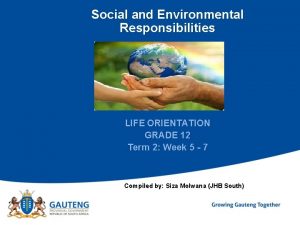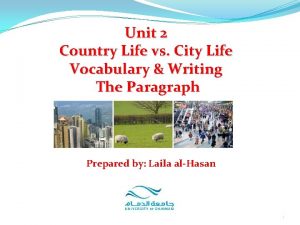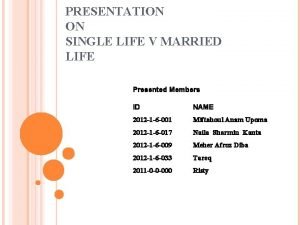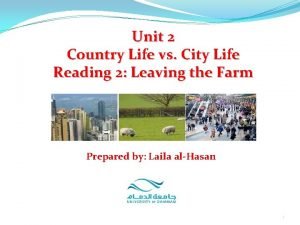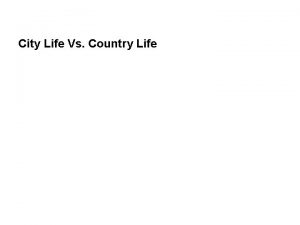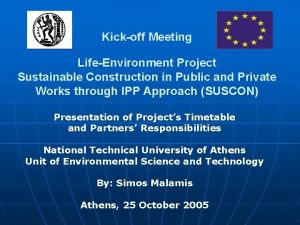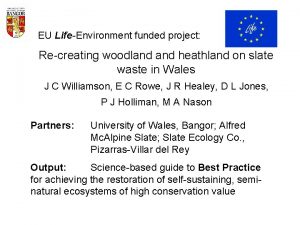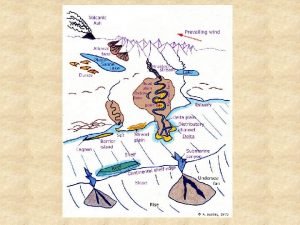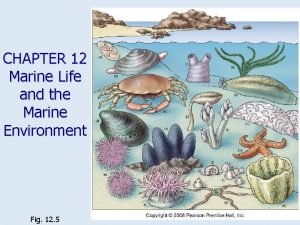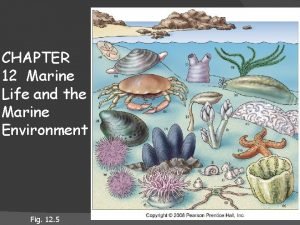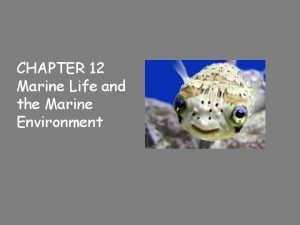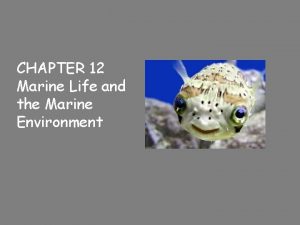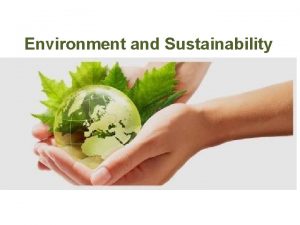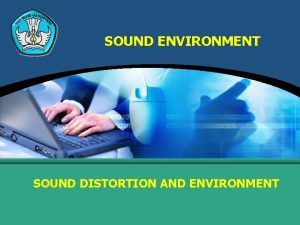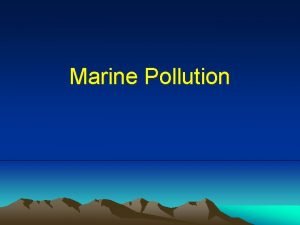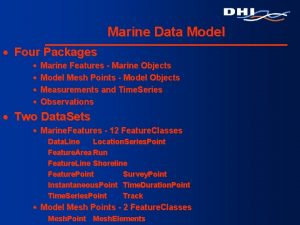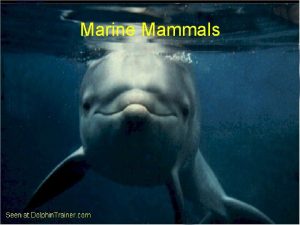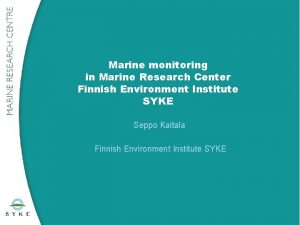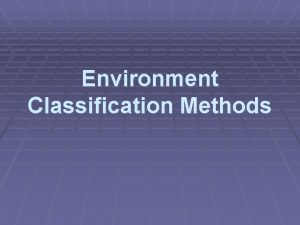Marine Life and the Marine Environment Marine LifeEnvironment

























































- Slides: 57

Marine Life and the Marine Environment.

Marine Life/Environment. • Marine Biologists have identified over 250, 000 oceanic species. This number increases every year. • Most marine life lives in shallow water near shore. • Sunlight is the key to life. (I. E. shallow water).

Marine Life/Environment. • I. Defining and Classifying Life. – A. Defining life. 1. Living things can capture store and transmit energy. 2. They are capable of reproduction. 3. They can adapt to environments. 4. They can change through time (evolution).

Marine Life/Environment. – B. The 3 domains of life (Most inclusive subdivision of life) • 1. Bacteria – Single celled, very small, no nuclei, no organelles. – a. Cyanobacteria is an marine example.

Marine Life/Environment. 2. Archaea – Single celled bacterial “like” organisms that prefer extreme environments (eg. Volcanic vents). Often produce methane and oxidize sulfer.

Marine Life/Environment. 2. Eukarya – Often multicellular, have nuclei, have organelles, often large and complex. a. Include Plants, Animals, Fungi and Protista

Marine Life/Environment. C. Domains can divided into 5 kingdoms. 1. Monera – Bacteria. Single celled, lack nuclei. – a. Include cyanobacteria, heterotrophic bacteria and archaea. 2. Plantae – Multicellular plants (includes algae. 3. Animalia – Multicellular animals 4. Fungi – Fungus, molds and ½ of lichens. Mostly terrestrial. 5. Protoctista – “catch-all” of organisms that do not fit neatly into the other kingdoms. Examples range from some types of algae to protozoans (like amoeba).

Marine Life/Environment.

Marine Life/Environment. • D. Kingdoms are then divided in to Phylum, Subphylum, Class, Order, Family, Genus and finally Species.

Marine Life/Environment. E. Species is the most exclusive order of taxonomic classification. 1. Members of a species may interbreed and produce fertile and viable offspring. Canis lupis

Marine Life/Environment • 2. Species name is always 2 words (the genus and species), in italics, first word (the genus) capitalized, and the second in small case. Eg. Homo sapien Carl Linnaeus

Marine Life/Environment. II. Classifying Marine organisms. (A. Plankton, B. Nekton, and C. Benthos) - Typically classified by what they do and where they live.

Marine Life/Environment. Plankton Nekton Benthos

Marine Life/Environment. A. Plankton (Floaters) – plants and animals that drift with ocean current. -Do not swim, or paddle with direction. - Make up most of earth’s biomass. -Jellyfish are the largest plankton species.

Marine Life/Environment. 1. Different types by feeding strategy. a. Phytoplankton – make their own food (photosynthesis) AKA autotrophic. b. Zooplankton – heterotrophic = eat their food.

Marine Life/Environment. 2. Some is bacterial = Bacterioplankton 3. Some is viral = Viroplankton

Marine Life/Environment. 4. Some is catagorized by life cycle. a. Holoplankton – whole life spent as plankton. b. Meroplankton – Only larval stages are plankton.

Marine Life/Environment. 5. Some categorized by size a. Macroplankton – large (eg. Jellyfish) b. Picoplankton – very small.

Marine Life/Environment. B. Nekton (swimmers) – they can swim. - most live in shallows near shore. -some spend part of life in fresh water and another part in salt water (salmon or eels).

Marine Life/Environment. C. Benthos (Bottom Dwellers) - Much higher concentration in shallows - Epifauna – live on surface of sea floor - Infauna – live buried in sediment at the bottom. - Nectobenthos – live on the bottom but can swim or crawl. (like crabs)

Marine Life/Environment. -Some benthos utilize deep water hydrothermal vents as energy. Dispelled hypothesis that they only existed in shallow water (sunlight).

Marine Life/Environment. III. How many marine species exist? We will not know for a very long time. Over two thousand new marine species cataloged each year. In 2000 The Census of Marine Life (Co. ML) began. -Extensive 10 year project to assess and catalog oceanic diversity.

Marine Life/Environment. • Currently only 250, 000 of 1, 750, 000 known species are marine. – One reason is the difficulty of underwater research. – Another is the oceans constant environment (less evolutionary pressure)

Marine Life/Environment. • Of known marine species 98% live in the Benthic Zone (bottom dwellers). = Benthos • 2% inhabit pelagic environment (within the water column) = nekton/plankton.

Marine Life/Environment. IV. Organisms adaptation to oceanic conditions. - Ocean environment is much more stable than terrestrial environments. - Therefore marine organisms have not evolved complex means of adaptation to change. -Therefore, small changes in Temperature, salinity etc. can be devastating.

Marine Life/Environment. - Water provides support for marine creatures. = Therefore animals must depend on buoyancy and frictional resistance to sinking (I. e. swimming and floating) =This requires special adaptations.

Marine Life/Environment. A. Adaptations to Water Viscosity. - Viscosity is a substance’s resistance to flow. = high viscosity means substance does not flow easily (toothpaste) = low viscosity = flows easily (water)

Marine Life/Environment. =Viscosity is affected by temperature and salinity. i. As temp increases, viscosity decreases. ii. As salinity increases, viscosity increases.

Marine Life/Environment. -Therefore, very small organisms in cold or very salty water do not require as many “extensions” to stay afloat (Plankton). = More extensive projections = more surface area to volume in ratio. = More surface area to volume = more buoyancy.

Marine Life/Environment. -Large animals must be streamlined to move efficiently through more viscous water. Fish shape is a prime example.

Marine Life/Environment. B. Temperature adaptations -Ocean temp is far more stable than terrestrial temperatures. =Including daily temps and seasonal temps.

Marine Life/Environment. -Four reasons for ocean temp stability. 1. Heat capacity of water is higher than land. 2. Evaporation slows heating of ocean. 3. Sunlight is distributed throughout many meters of depth in the oceans. 4. Currents, waves and tides distribute heat.

Marine Life/Environment. -Warm vs. Cold water species. = Warm water plankton smaller with more projections (more ornate). = Warm water organisms = shorter life cycle. =Warm water organisms = more biodiversity, BUT less biomass.

Marine Life/Environment. C. Salinity – Due to osmotic pressure organisms have varying degrees of tolerance to salinity change. - Euryhaline – organisms that can tolerate a range of salinity (estuaries) - Stenohaline – organisms that tolerate little range of salinity (open ocean)

Marine Life/Environment. - Diffusion – movement of molecules (often dissolved in water) from high concentration to low concentration. - Osmosis – movement of water from high “free water” concentration to low “free water” concentration across a membrane.

Marine Life/Environment. - Isotonic solution – Solution with equal solutes on both sides of membrane (no net movement).

Marine Life/Environment. - Hypotonic sol. – Solution with less solutes than inside cell or organism. (Water diffuses into cell/organism).

Marine Life/Environment. - Hypertonic sol. – Sol. with more solutes than in cell / organism. (Water diffuses out of cell / organism).

Marine Life/Environment Osmotic pressure – increases as the difference in solute concentration increases.

Marine Life/Environment. -Adaptations – = Saltwater fish are hypotonic to their environment. They drink large amounts of water and release salt from gills and through urine.

Marine Life/Environment. = Freshwater fish are hypertonic to their environment. They do not drink water and release large amounts of diluted urine.

Marine Life/Environment. D. Dissolved Gasses – Cold water dissolves More gas than warm water. - High latitude oceans produce large quantities of plankton due to high CO 2 and O 2 concentrations. - Most marine organisms utilize gills to exchange gasses.

Marine Life/Environment -Most marine organisms utilize gills to exchange gasses. -Water enters through mouth, passes gills and exits through gill slits.

Marine Life/Environment E. Water’s high transparency. - Light penetrates ocean water to 1000 meters. - Due to transparency predators often rely on site.

Marine Life/Environment -To counter predation marine organisms often migrate vertically to remain just under light penetration. - Some counter-shade (dark on top light underneath). -Some are transparent……Jellyfish.

Marine Life/Environment V. Main Divisions of the Marine Environment. -Two main divisions = Pelagic Environment (open sea) and Benthic Environment (Sea bottom).

Marine Life/Environment -Sunlight penetration side note. = Euphotic Zone – From surface to about 100 meters (enough light for photosynthesis). = Disphotic Zone – 100 m through 1000 m (small but measurable light). = Aphotic Zone – 1000 m+ (No light)

Marine Life/Environment A. Pelagic Environment – Divided into neritic and oceanic provinces.

Marine Life/Environment 1. Neritic province ( from coast seawardwater less than 200 m in depth). -High concentration of species diversity– biodiversity typically decreases moving from continental margins to open sea. - Influenced by breaking waves, tidal movements, seasonal variations in temperatue and salinity.

Marine Life/Environment 2. Oceanic Province – Seaward from point where depth exceeds 200 m – -Divided into 4 biozones (Epipelagic, mesopelagic, bathypelagic and abyssopelagic zones).

Marine Life/Environment a. Epipelagic Zone – Only zone with enough light for photosynthesis (photic zone).

Marine Life/Environment b. Mesopelagic Zone – Minimum light. -Many organisms capable of bioluminescence. -Deep scattering layer (caused by high concentration of plankton) located here.

Marine Life/Environment c. Bathypelagic and Abyssopelagic Zones – No light. - Most organisms blind. - Most predatory -Most have sharp teeth, very large mouths and small bodies.

Marine Life/Environment B. Benthic Environment (Sea Bottom) – Divided into Supralittoral zone, Subneritic province, and Suboceanic province. 1. Supralittoral zone – only emersed during tsunamies and severe storms (spray zone).

Marine Life/Environment 2. Subneritic Province – High tide shoreline to 200 m depth. a. Littoral zone – Between high and low tide. b. Sublittoral zone – Low tide to 200 m deep. i. Inner sublittoral zone– area algae remains attached to the sea floor (about 50 m depth) ii. Outer sublittoral zone – Algae freefloating (50 m to 200 m depth)

Marine Life/Environment 3. Suboceanic Province – divided into bathyal, abyssal and hadal zones. a. Bathyal zone – 200 – 4000 m depth. b. Abyssal zone – 4000 – 6000 m depth. c. Hadal zone – 6000+m i. Associated with deep-sea trenches.

Marine Life/Environment
 Chapter 16 the marine environment
Chapter 16 the marine environment Copernicus
Copernicus Financial environment of business
Financial environment of business Hình ảnh bộ gõ cơ thể búng tay
Hình ảnh bộ gõ cơ thể búng tay Frameset trong html5
Frameset trong html5 Bổ thể
Bổ thể Tỉ lệ cơ thể trẻ em
Tỉ lệ cơ thể trẻ em Chó sói
Chó sói Tư thế worm breton là gì
Tư thế worm breton là gì Chúa sống lại
Chúa sống lại Các môn thể thao bắt đầu bằng từ đua
Các môn thể thao bắt đầu bằng từ đua Thế nào là hệ số cao nhất
Thế nào là hệ số cao nhất Các châu lục và đại dương trên thế giới
Các châu lục và đại dương trên thế giới Công thức tính thế năng
Công thức tính thế năng Trời xanh đây là của chúng ta thể thơ
Trời xanh đây là của chúng ta thể thơ Mật thư anh em như thể tay chân
Mật thư anh em như thể tay chân Làm thế nào để 102-1=99
Làm thế nào để 102-1=99 Phản ứng thế ankan
Phản ứng thế ankan Các châu lục và đại dương trên thế giới
Các châu lục và đại dương trên thế giới Thể thơ truyền thống
Thể thơ truyền thống Quá trình desamine hóa có thể tạo ra
Quá trình desamine hóa có thể tạo ra Một số thể thơ truyền thống
Một số thể thơ truyền thống Cái miệng bé xinh thế chỉ nói điều hay thôi
Cái miệng bé xinh thế chỉ nói điều hay thôi Vẽ hình chiếu vuông góc của vật thể sau
Vẽ hình chiếu vuông góc của vật thể sau Thế nào là sự mỏi cơ
Thế nào là sự mỏi cơ đặc điểm cơ thể của người tối cổ
đặc điểm cơ thể của người tối cổ V cc cc
V cc cc Vẽ hình chiếu đứng bằng cạnh của vật thể
Vẽ hình chiếu đứng bằng cạnh của vật thể Fecboak
Fecboak Thẻ vin
Thẻ vin đại từ thay thế
đại từ thay thế điện thế nghỉ
điện thế nghỉ Tư thế ngồi viết
Tư thế ngồi viết Diễn thế sinh thái là
Diễn thế sinh thái là Các loại đột biến cấu trúc nhiễm sắc thể
Các loại đột biến cấu trúc nhiễm sắc thể Các số nguyên tố
Các số nguyên tố Tư thế ngồi viết
Tư thế ngồi viết Lời thề hippocrates
Lời thề hippocrates Thiếu nhi thế giới liên hoan
Thiếu nhi thế giới liên hoan ưu thế lai là gì
ưu thế lai là gì Sự nuôi và dạy con của hươu
Sự nuôi và dạy con của hươu Sự nuôi và dạy con của hổ
Sự nuôi và dạy con của hổ Hệ hô hấp
Hệ hô hấp Từ ngữ thể hiện lòng nhân hậu
Từ ngữ thể hiện lòng nhân hậu Thế nào là mạng điện lắp đặt kiểu nổi
Thế nào là mạng điện lắp đặt kiểu nổi Importance of marine life
Importance of marine life Marine life zones diagram
Marine life zones diagram Grade 10 life orientation
Grade 10 life orientation City life vocabulary
City life vocabulary Slidetodoc.com
Slidetodoc.com Marriage life vs single life
Marriage life vs single life Unit 8 country life and city life
Unit 8 country life and city life Farm life vs city life
Farm life vs city life Real life uses of polynomials
Real life uses of polynomials Country life vs city life compare /contrast
Country life vs city life compare /contrast City life vs country life
City life vs country life What does life of pi teach us
What does life of pi teach us Boundaries meme
Boundaries meme
